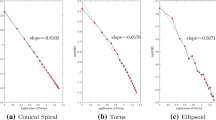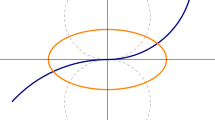Abstract
A standard reconstruction problem is how to discover a compact set from a noisy point cloud that approximates it. A finite point cloud is a compact set. This paper proves a reconstruction theorem which gives a sufficient condition, as a bound on the Hausdorff distance between two compact sets, for when certain offsets of these two sets are homotopic in terms of the absence of μ-critical points in an annular region. We reduce the problem of reconstructing a subset from a point cloud to the existence of a deformation retraction from the offset of the subset to the subset itself. The ambient space can be any Riemannian manifold but we focus on ambient manifolds which have nowhere negative curvature (this includes Euclidean space). We get an improvement on previous bounds for the case where the ambient space is Euclidean whenever μ≤0.945 (μ∈(0,1) by definition). In the process, we prove stability theorems for μ-critical points when the ambient space is a manifold.



Similar content being viewed by others
Notes
θ∈[0,π/2].
In particular, for any compact set K and any bound on Hausdorff distance δ>0 there is a compact set L with zero μ-reach such that d H (K,L)<δ.
∥∇ x f∥ is the non-negative number \(\max\{0,\limsup_{y\to x} \frac {f(y)-f(x)}{d(y,x)}\}\). That this is ∥∇ K (x)∥ follows from our geometric construction of ∇ K (x) and from the cosine rule.
Abbreviations
- \(\mathcal {M}\) :
-
is a smooth Riemannian manifold which forms the ambient space.
- A :
-
is a compact subset of \(\mathcal {M}\) which we desire to reconstruct.
- S :
-
is a noisy point cloud sample of A.
- δ :
-
is a bound on the Hausdorff distance between two compacts sets.
- \(\mathit{UT}\mathcal {M}\) :
-
is the unit tangent bundle of \(\mathcal {M}\).
- \(T_{x}\mathcal {M}\) :
-
is the tangent plane to \(\mathcal {M}\) at the point x.
- γ :
-
is a geodesic on \(\mathcal {M}\) (usually unit speed and always constant speed).
- x,y,z :
-
are points in \(\mathcal {M}\).
- exp x :
-
is the exponential map from the tangent plane at x to \(\mathcal {M}\).
- Γ(γ):
-
is the isometry between tangent planes induced by parallel transport along γ.
- w,v :
-
are unit tangent vectors.
- β,θ :
-
are angles. We mainly care about acute angles.
- C(w,β):
-
is a cone. It is a ball in the unit tangent sphere at a point in \(\mathcal {M}\) with center w and radius β.
- W :
-
is a cone field. Also denoted by {(x,C(w x ,β x ))}.
- W′:
-
denotes the complementary cone field to W when W is an acute cone field. For W above it is {(x,C(w x ,π/2−β x ))}.
- X :
-
is a vector field.
- K,L :
-
are compact subsets of \(\mathcal {M}\).
- d K :
-
is the distance function from K.
- K a :
-
is the a-offset of K. That is, \(\{ x\in \mathcal {M}: d_{K}(x)\leq a\}\).
- K [a,b] :
-
is the [a,b] annulus of K. That is, {x∈M:a≤d K (x)≤b}.
- ∇ K :
-
is the gradient vector field for d K .
References
N. Amenta, S. Choi, T.K. Dey, N. Leekha, A simple algorithm for homeomorphic surface reconstruction, in Proceedings of the Sixteenth Annual Symposium on Computational Geometry (ACM, New York, 2000), pp. 213–222.
D. Attali, A. Lieutier, D. Salinas, Vietoris–Rips complexes also provide topologically correct reconstructions of sampled shapes, Comput. Geom. (2012).
A. Bissacco, P. Saisan, S. Soatto, Gait recognition using dynamic affine invariants, in Proc. Int’l Symp. Math. Theory of Networks and Systems, Citeseer (2004).
G. Carlsson, Topology and data, Bull. Am. Math. Soc. 46(2), 255–308 (2009).
J.M. Chang, M. Kirby, H. Kley, C. Peterson, B. Draper, J. Beveridge, Recognition of digital images of the human face at ultra low resolution via illumination spaces, in Computer Vision—ACCV 2007, (2007), pp. 733–743.
F. Chazal, S.Y. Oudot, Towards persistence-based reconstruction in Euclidean spaces, in Proceedings of the Twenty-Fourth Annual Symposium on Computational Geometry (ACM, New York, 2008), pp. 232–241.
F. Chazal, D. Cohen-Steiner, A. Lieutier, A sampling theory for compact sets in Euclidean space, Discrete Comput. Geom. 41(3), 461–479 (2009).
J. Cheeger, D.G. Ebin, American Mathematical Society, Comparison Theorems in Riemannian Geometry (1975). AMS Chelsea Publishing.
T.K. Dey, K. Li, E.A. Ramos, R. Wenger, Isotopic reconstruction of surfaces with boundaries, in Computer Graphics Forum. Wiley Online Library, vol. 28 (2009), pp. 1371–1382.
G. Doretto, A. Chiuso, Y.N. Wu, S. Soatto, Dynamic textures, Int. J. Comput. Vis. 51(2), 91–109 (2003).
H. Edelsbrunner, E.P. Mücke, Three-dimensional alpha shapes, in Proceedings of the 1992 Workshop on Volume Visualization (ACM, New York, 1992), pp. 75–82.
J.H.G. Fu, Tubular neighborhoods in Euclidean spaces, Duke Math. J. 52(4), 1025–1046 (1985).
R. Ghrist, Barcodes: the persistent topology of data, Bull. Am. Math. Soc. 45(1), 61–75 (2008).
K. Grove, Critical point theory for distance functions. in Proc. of Symposia in Pure Mathematics, vol. 54 (1993).
M.C. Irwin, Smooth Dynamical Systems. Pure and Applied Mathematics (Academic Press, San Diego, 1980).
J.M. Lee, Riemannian Manifolds: An Introduction to Curvature. Graduate Texts in Mathematics (Springer, Berlin, 1997).
A. Lieutier, Any open bounded subset of \(\mathbb{R}^{n}\) has the same homotopy type than its medial axis, in Proceedings of the Eighth ACM Symposium on Solid Modeling and Applications (ACM, New York, 2003), pp. 65–75.
A. Lytchak, Open map theorem for metric spaces, Algebra Anal. 17(3), 139–159 (2005).
P. Niyogi, S. Smale, S. Weinberger, Finding the homology of submanifolds with high confidence from random samples, Discrete Comput. Geom. 39(1–3), 419–441 (2008).
V. Patrangenaru, K.V. Mardia, Affine shape analysis and image analysis, in Stochastic Geometry, Biological Structure and Images, Dept. of Statistics, University of Leeds (2003), pp. 56–62.
Author information
Authors and Affiliations
Corresponding author
Additional information
Communicated by Herbert Edelsbrunner.
Rights and permissions
About this article
Cite this article
Turner, K. Cone Fields and Topological Sampling in Manifolds with Bounded Curvature. Found Comput Math 13, 913–933 (2013). https://doi.org/10.1007/s10208-013-9176-6
Received:
Revised:
Accepted:
Published:
Issue Date:
DOI: https://doi.org/10.1007/s10208-013-9176-6




